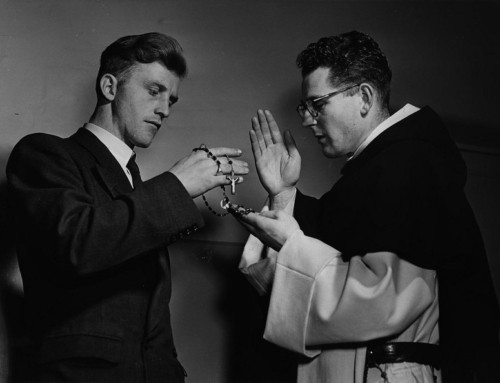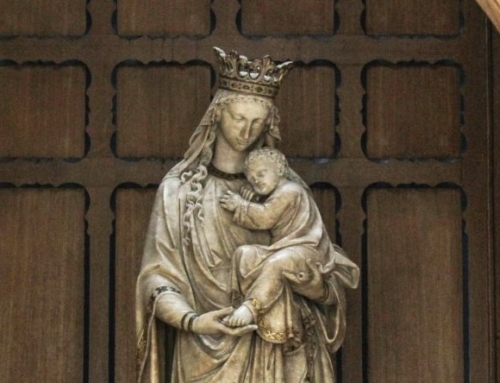Sherry A. Weddell, ed., Becoming a Parish of Intentional Disciples. Huntington, IN: Our Sunday Visitor, 2015.
A whole generation of saints was formed by the renewal of parish life. It began on September 14, 1594, when St. Francis de Sales “set out on foot—with a single companion—to re-evangelize the 60,000 formerly Catholic inhabitants of a region called the Chablais in alpine France” (11). De Sales saw less than one hundred Catholics in the sixty-five parishes of that region. Four years later, there were 40,000 Catholics filling the pews for Forty Hours of Eucharistic Adoration.
Sherry A. Weddell, Co-Director of the Catherine of Siena Institute, an international ministry affiliated with the Western Dominican Province, follows up her immensely successful first book, Forming Intentional Disciples: The Path to Knowing and Following Jesus, with Becoming a Parish of Intentional Disciples. She begins by revealing the vision for parish life: sainthood.
Seventeenth-century France saw a renewal of Catholic life by the efforts of key figures like SS. Francis de Sales, John Eudes, Vincent de Paul, and Louise de Marillac. They called on all lay people, women and men religious, priests and deacons “to personal union with Jesus” (16). This same call applies today. All Christians are called to holiness: the “tens of thousands of Catholics in the pews and the many thousands of clerical and lay leaders” in parishes, “from the smallest and most rural to the largest congregations in the United States” and throughout the world (8).
All Catholics who are involved in parish ministry would profit from the insights contained in this book. Its goal is to form intentional disciples of Jesus Christ among those already in the pews and those who have not been to church in a while. Weddell asks the reader:
Are we open to, are we willing to answer God’s call with the same passion and lifelong obedience that enabled the generation of saints to transform French Catholicism and impact their entire nation for seven generations? Are we willing to answer the call and pay the price necessary to become a new generation of saints, through which God can do extraordinary things in our time? (27)
In Becoming a Parish of Intentional Disciples, Weddell has gathered the essays of experienced leaders and collaborators in order to help her readers see how parish life and parishioners can be radically transformed. The book’s scope extends from the overall vision of the parish to the life-changing impact on individuals. Throughout the pages of this book, the authors continually reveal that the parish is meant to form disciples of Jesus Christ.
This transformation begins with prayer, particularly through intercessory prayer. This helps to move the hearts of others toward discipleship with Christ. As author Keith Strohm, a collaborator with the Catherine of Siena Institute, puts it:
Intercessory prayer disrupts the “infrastructure” of the enemy, by which I mean it weakens and destroys the network of lies, fear, intimidation, and confusion—the tools and strategies used by Satan to keep persons and situations away from God’s peace, clarity, and redeeming love. In changing the spiritual climate around a person or community, this kind of prayer helps till the soil of the heart and prepares it to receive the seed of the Gospel. (32)
There can be a “culture of silence” in Catholic parishes: “This culture works against the spread of the Gospel by reinforcing attitudes that make it difficult for people to speak about their relationship with Jesus to others” (30). Intercessory prayer among parishioners helps other parishioners to break the silence and cooperate with the promptings of the Holy Spirit.
Father Michael Fones, O.P., Co-Director of the Catherine of Siena Institute, writes on how the laity are co-responsible for the mission of Christ. He makes the interesting connection that the pastor and the laity have a “nuptial character that transcends the hierarchical”:
As the mutual love of husband and wife bears fruit in the begetting and raising of children (for which they are obviously co-responsible!), the clergy and laity together with God’s grace are co-responsible for responding to the commission of Christ. And the fruitfulness of that co-responsibility is making disciples—spiritual children—of all the nations. (49)
Father Fones proposes an idea for parish councils to pursue this vision for their parish by calling the parish community and individual members of the community to apostolic initiatives. For example, Holy Apostles Parish in Colorado Springs, Colorado, held a synod for its parishioners which identified nine groups that could be reached: the elderly, the poor, the disabled, the immigrants, the single-parent families, the youth, the military personnel and their families, the fallen-away Catholics, and the unchurched. At the assembly, “parishioners were asked to reflect on how Christ might be calling individual members of his Body to respond to the real situations facing their neighbors” and “were invited to select one group that they felt called to reach out to in some way” (57). Individuals made a public commitment to the parish community to explore the specific needs of the people in their parish. Commissions for the nine groups were formed, and these nine commissions would regularly report to the parish council in order for the pastor and the parish community to bring Christ to the margins. An apostolic initiative for a parish is challenged to shift “from doing the work of Christ to animating the work of Christ” who forms His disciples (59).
Bobby Vidal, Director of Evangelization and Lay Formation for St. Kateri Tekakwitha Church in Santa Clarita, California, discusses the difference between a “maintenance-driven parish” and a “mission-driven parish.” The transformation of a parish into the latter begins by asking reflection questions that possess a “spiritual power,” such as “Who do you say that I am?” (Mk 8:29) and “Do you take this woman to be your wife?” This process of self-inquiry should extend to issues with a missionary character, e.g., “How can we assist individuals to commit their entire life to Jesus?” and “How do we form others in the task of transforming the secular world with the light of the Gospel?”
Father Chas Canoy, a priest of the Diocese of Lansing, Michigan, presents an enlightening experience of having “fireside chats” in the homes of his parishioners. He would simply “pop a cold one” with his parishioners in Jackson, Michigan, and “spend time getting to know them” (104). These “fireside chats” would give parishioners the opportunity to discuss the Catholic faith and how to grow in their relationship with Christ. Father Canoy found that this fostered “trust and solidarity between the pastor and the parishioners,” the first “threshold of conversion” from Weddell’s first book (104–105).
Finally, Jim Beckman, Founder of YDisciple, offers some fascinating insights into rethinking youth ministry. He names various difficulties in reaching out to teens: “increased moral relativism among teens, increased confusion over basic questions about faith, the chaotic and busy lifestyles of teens and their families, and so forth” (118). Beckman also debunks some myths about teens and Catholic youth ministry, such as that teens hate their parents and that teen participation in youth events equals success. It is rather the opposite: Teens are looking for support and love from their parents, especially when it comes to being engaged in their faith. Furthermore, participation at youth events does not necessarily translate into “a lifelong commitment to being a disciple of Jesus Christ” (123). Beckman proposes the apostolic model of YDisciple, which attends to the basic needs of teens to be accepted and loved, especially by adults, while helping them to grow in intimacy with Christ and fellowship with their peers.
Overall, Becoming a Parish of Intentional Disciples helps the reader to reflect on his or her experience of parish life and may inspire the transformation of parishes and parishioners into leading lives of holiness. The thought of Pope Francis is clearly present in this collection of essays, as his Apostolic Exhortation Evangelii Gaudium is extensively quoted throughout the book. At the end of her essay titled “A Parish Moves Ahead,” Katherine Coolidge, the Called & Gifted Coordinator for the Catherine of Siena Institute, quotes Pope Francis: “Every Christian is a missionary to the extent that he or she has encountered the love of God in Christ Jesus: we no longer say that we are ‘disciples’ and ‘missionaries,’ but rather that we are always ‘missionary disciples.’”
To download a printable PDF of this Article from
Dominicana Journal, Winter 2015, Vol LVIII, No. 2, CLICK HERE.




